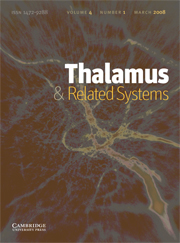Article contents
Postnatal maturational properties of rat parafascicular thalamic neurons recorded in vitro
Published online by Cambridge University Press: 03 January 2006
Abstract
Thalamic relay neurons have homogeneous, adult-like firing properties and similar morphology by 12 days postnatally (PN 12). Parafascicular (Pf) neurons have a different morphology compared with typical thalamic relay neurons, but the development of their electrophysiological properties is not well studied. Intracellular recordings in PN 12–50 Pf neurons revealed several heterogeneous firing patterns different from those in thalamic relay neurons. Two types of cells were identified: Type I cells displayed a fast afterhyperpolarization (AHP) followed by a large-amplitude, slow AHP; whereas Type II cells had only a fast AHP. These cell types had overlapping membrane properties but differences in excitability. Some properties of Pf neurons were adult-like by PN 12, but, unlike thalamic relay neurons, there were significant maturational changes thereafter, including decreased action potential (AP) duration, increased fast AHP amplitude and increased excitability. Pf neurons did not exhibit rhythmic bursting and generally lacked low-threshold spike (LTS) responses that characterize thalamic relay neurons. Pf neurons exhibited non-linear I-V relationships, and only a third of the cells expressed the time and voltage-dependent hyperpolarization activated (Ih) current, which declined with age. These results indicate that the morphological differences between Pf neurons and typical thalamic relay neurons are paralleled by electrophysiological differences, and that Pf membrane properties change during postnatal development.
Information
- Type
- Research Article
- Information
- Copyright
- © 2006 Cambridge University Press
- 11
- Cited by

